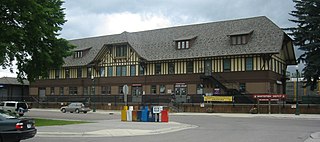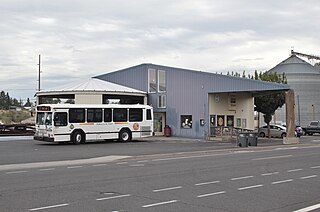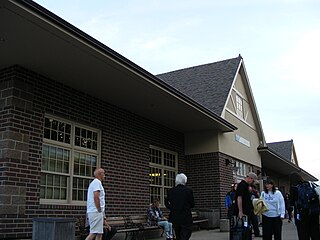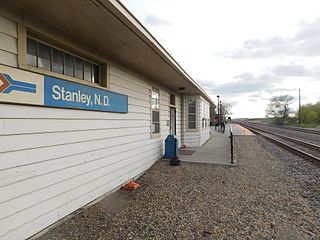
The Empire Builder is a daily long-distance passenger train operated by Amtrak between Chicago and either Seattle or Portland via two sections west of Spokane. Introduced in 1929, it was the flagship passenger train of the Great Northern Railway and was retained by Amtrak when it took over intercity rail service in 1971.

Saint Paul Union Depot is a historic railroad station and intermodal transit hub in the Lowertown neighborhood of Saint Paul, Minnesota. It serves light rail, intercity rail, intercity bus, and local bus services.

Midway is a former Amtrak intercity train station in the Midway neighborhood of Saint Paul, Minnesota, United States. It was last served by Amtrak's daily Empire Builder, with service from Chicago, Illinois to Seattle, Washington or Portland, Oregon. When the station opened March 1, 1978, it was also served briefly by the long-distance North Coast Hiawatha, and the Hiawatha and Arrowhead, the latter combined as the North Star later that year.

Whitefish station is a stop on Amtrak's Empire Builder in Whitefish, Montana. In addition to the Empire Builder, a once-daily Greyhound Lines bus service also links the station to Kalispell and Missoula. A car rental agency operates a window within the station. The station and parking lot are owned by the Stumptown Historical Society. BNSF Railway leases office space on the upper floors of the station and owns the platform and track.

Ephrata is a train station on Amtrak's Empire Builder line in Ephrata, Washington. The station and parking are owned by the city government, while the track and platforms are owned by BNSF Railway. Northwestern Trailways provides inter-city bus transportation next to the station while local transit is provided by the Grant Transit Authority.

Columbia Station, also known as Wenatchee station, is an intermodal train and bus station in Wenatchee, Washington, United States. It is a stop on Amtrak's Empire Builder train and is the main hub for Link Transit, the local bus system serving Wenatchee and surrounding areas. The station is also served by intercity buses operated by Grant Transit Authority, Northwestern Trailways, and Travel Washington.

The Northern Transcon, a route operated by the BNSF Railway, traverses the most northerly route of any railroad in the western United States. This route was originally part of the Chicago, Burlington and Quincy Railroad, Northern Pacific Railway, Great Northern Railway and Spokane, Portland and Seattle Railway systems, merged into the Burlington Northern Railroad system in 1970.

St. Cloud station is an Amtrak intercity train station in St. Cloud, Minnesota, United States. It is served by the daily Empire Builder on its route connecting Chicago, Illinois to Seattle, Washington and Portland, Oregon. The next stop westbound is Staples while the next stop eastbound is Saint Paul Union Depot.

Staples station is an Amtrak intercity train station in Staples, Minnesota, United States, served by Amtrak's daily Empire Builder service. It was built in December 1909 by the Northern Pacific Railway. The architects of the station were Charles A. Reed and Allen H. Stem, who also designed the Northern Pacific's King Street Station in Seattle, Washington, and the New York Central Railroad's Grand Central Terminal in New York City.

Grand Forks station is a train station in western Grand Forks, North Dakota. It is served by Amtrak's Empire Builder line.

Rugby station is a train station in Rugby, North Dakota served by Amtrak's Empire Builder line. The station was built in 1907 as the Great Northern Passenger Depot. In 1987 a local Lions Club chapter was among the groups involved in a restoration project for the station. The former Great Northern Depot was placed on the National Register of Historic Places on September 26, 1991.

Minot station is a train station in Minot, North Dakota served by Amtrak, the national railroad passenger system. The station is located at the site of the former Great Northern Railway station, adjacent to the Minot Public Library, and close to Minot's City Hall and Downtown Minot.

Stanley station is a train station in Stanley, North Dakota served by Amtrak's Empire Builder line. The platform, tracks, and wooden depot are owned by BNSF Railway. It was originally a Great Northern Railway station that was a replacement for an earlier one, which is now a private residence.

Williston station is a train station in Williston, North Dakota, served by Amtrak's Empire Builder line. The brick station was built in 1910 by the Great Northern Railway and is located at the southern end of Williston's downtown. An interior and exterior restoration, begun in 2010 and costing almost $2 million, has returned the station to its original look.
There are several passenger rail projects being discussed in Minnesota. There is one existing commuter rail service in the state, the Northstar Line, and two existing long-distance intercity rail services, the Empire Builder and the Borealis. Future projects include a mixture of short-distance commuter rail and medium-distance regional rail lines which would run from the Twin Cities outward to neighboring states and perhaps Canada.

The Minneapolis Great Northern Depot, also known as Great Northern Station, was a passenger railroad station which served Minneapolis, Minnesota, USA. It was built in 1913 and demolished in 1978. It was located on Hennepin Avenue next to the Hennepin Avenue Bridge and across the street from the main Minneapolis Post Office.

The Wayzata Subdivision or Wayzata Sub is a railway line that runs about 93 miles (150 km) from Willmar to Minneapolis, Minnesota. Currently operated by BNSF Railway, this was part of the Great Northern Railway's transcontinental line from Minneapolis to Seattle, Washington. Today, BNSF's Northern Transcon travels up the Staples Subdivision instead, which is a more direct route to Fargo, North Dakota. West of Target Field station the Wayzata Sub sees about 4-6 trains a day, consisting of manifest, grain, and ethanol traffic. The Wayzata Sub also occasionally sees other commodities such as coal and oil trains, and can sometimes receive intermodal or Amtrak reroutes when needed.
The Morris Subdivision or Morris Sub is a railroad line that runs about 113 miles (182 km) from Breckenridge to Willmar, Minnesota. Currently operated by BNSF Railway, this was part of the Great Northern Railway's transcontinental line from Minneapolis to Seattle, Washington. Today, BNSF's Northern Transcon travels up the Staples Subdivision instead, which is a more direct route to Fargo, North Dakota.
The Moorhead Subdivision or Moorhead Sub is a railroad line which runs from Moorhead to Breckenridge, Minnesota. It briefly crosses the border into North Dakota around Wahpeton, across the Red River from Breckenridge. Currently operated by BNSF Railway, this was part of the Great Northern Railway's transcontinental line from Minneapolis to Seattle, Washington.

The Fargo station is a former railway station in Fargo, North Dakota. Built in 1898, it was listed on the National Register of Historic Places in 1975 as the Northern Pacific Railway Depot.





















